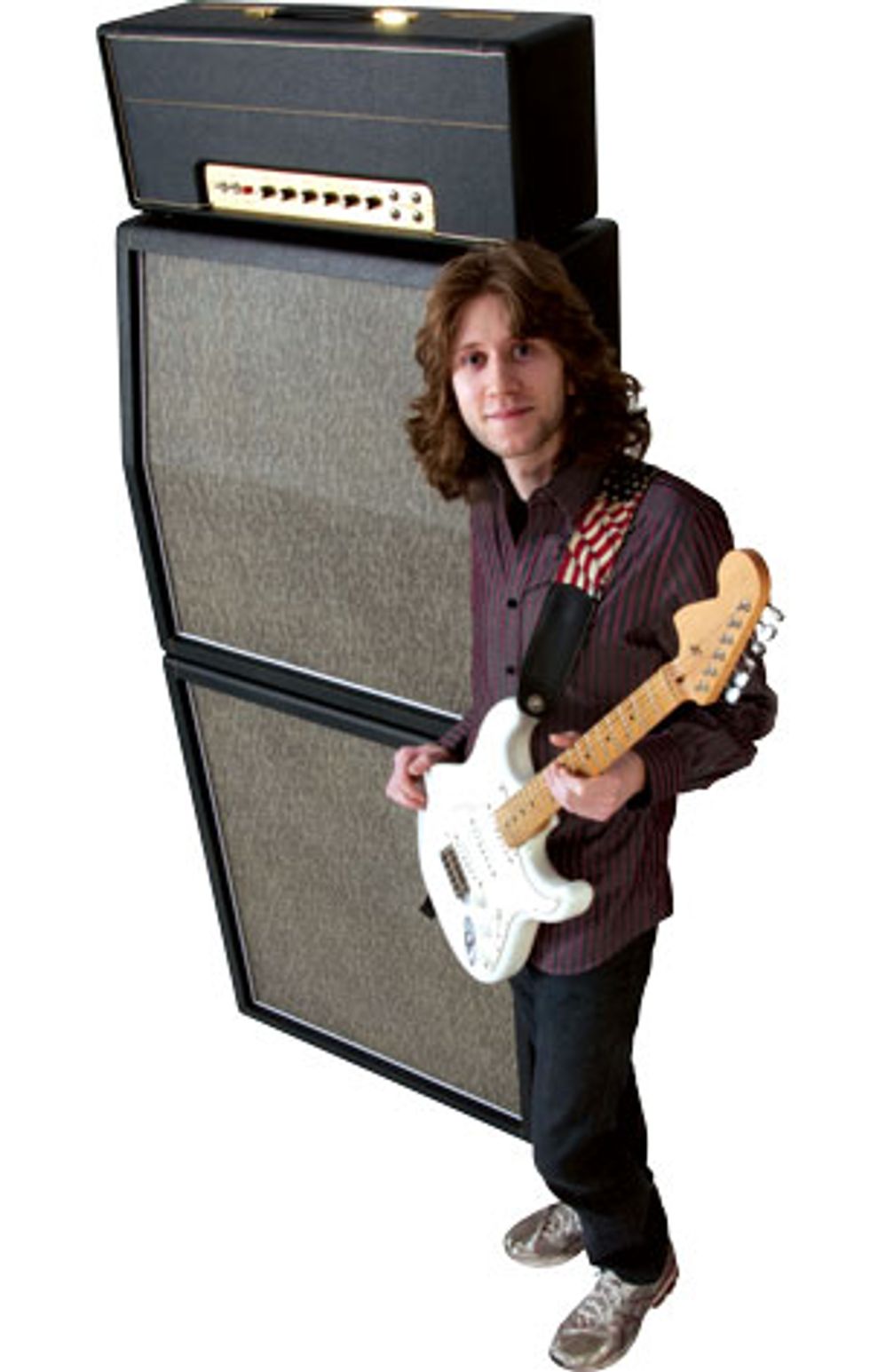
Builder Kyle Chase with a replica 1966 Marshall stack and a late-1960s-era Fender Stratocaster repro with reverse neck, reverse pickups, and reverse-angle bridge pickup. Notice the replica gold slim vents on top of the amplifier head. Photo-by-Andy.com
There’s certainly no shortage of boutique manufacturers and DIYers offering their take on the iconic gear of guitardom. Marshall plexis from the ’60s, vintage Fender Bassmans and Strats, old Electro-Harmonix Big Muffs, and finicky Echoplexes, among many others, have served as inspiration for countless new builds and reissues. However, exact replicas are virtually impossible to produce because most of the parts that went into these instruments are now virtually impossible to source in reliably replenishable quantities. Sure, you could cannibalize a vintage workhorse if you had one lying around—and, of course, there’s the burgeoning new-oldstock (NOS) tube market for your glass fix—but generally speaking, you’re out of luck if you’re after 100 percent authenticity. That’s why you have to be prepared to shell out the big bucks when you seek out vintage classics on eBay or Craigslist. And even if you do manage to snag a vintage gem, unless it’s an über-rare, kept-in-the-attic-for-decades prize, it will likely have or need replacement components.
Enter Kyle Chase of Chase Audio, an ultra-obsessive tone freak who builds replica amps, effects, and even guitars using only NOS parts—or, when those are impossible to come by, using custom parts made to period-correct specs. Yes, NOS is Chase’s MO. In fact, he’s so intent on building authentic, museum-quality replicas that he spends exorbitant amounts of time sourcing parts that are seemingly mundane and interchangeable—like wire and fuse holders—from around the world. He’s so fastidious that it took nearly eight years to complete his first Marshall JTM45/100 replica. His other builds include replicas of Fender Champs and Strats, Vox Clyde McCoy and Grey wahs, vintage Cry Baby wahs, Dallas-Arbiter Fuzz Faces, and Echoplex preamps, among many others. Because of the difficulty of finding the stuff Chase works with, he’s an underground phenomenon—you’re not likely to find information about him on forums, because only the absolute geekiest of gear freaks know of him … well, until now. His creations are finally starting to circulate. For example, his McCoy wah replica will be featured in an upcoming guitar-tone instructional DVD by Favored Nations artist Doug Doppler.
For the most part, Chase’s outfit is a one-man operation. His shop is located on his family’s property, 13 acres of isolated forest on the highest part of a mountain near Wilkes-Barre, Pennsylvania. The advantage of this remote locale is that Chase can crank his creations to Madison Square Garden levels without getting visits from the cops. Although he’s already quite accomplished as a builder, Chase continues to channel his energies into the pursuit of sonic nirvana, and to that end he’s currently pursuing a bachelor’s in electrical engineering with an emphasis in electronics.
Before we get to what led you to your
remarkable commitment to authentic
vintage tone, which guitarists inspired
you as a player?
Some of my favorite guitarists are Jimi
Hendrix, Eric Clapton, Eddie Van Halen,
Jeff Beck, David Gilmour, and Neil Young,
although the list could go on and on.
Did those players also shape your concept
of tone and what you’re trying to achieve
sonically with your period-correct replicas?
Yes and no. Each one of those artists has a tone
that represents them, and some have many
different tones. Jimi Hendrix’s tone was always
evolving. Eddie Van Halen was a big influence
on me, but I was more a fan of what he had to
say on the guitar—his voice. Thinking about
some of his great tones came later.
What was your first tube amp?
The first real tube amp I had was a Marshall
JCM2000 TSL602 2x12 combo, and my
first quality electric guitar was a custom
shop Peavey Wolfgang. Both were purchased
as gifts for me from my mother
during my senior year in high school.
This setup made it effortless to play in
the style of Van Halen, Vai, and Satriani.
To this day, I favor it for certain tones.
The TSL602 and TSL601 1x12 are
nice amps, but they don’t seem to get
that much love from gearheads. Did
you mod yours at all?
No, I like it the way it is. People get
caught up in modifying things. I modified
my Tube Screamer every possible way
you can, but for my personal taste, I like
it stock—the way it was originally made.
I actually almost got rid of my TSL602 at one point. I traded it in at Guitar Center in Philadelphia but after a couple of weeks I thought to myself, “Man, I think I want that back.” I went back and went through all these different TSL602s, but none of them sounded like the one I had. I did end up getting my original back, though—I had it sourced back through Guitar Center. That amp has sentimental value, too.
What are your benchmarks for good tone?
The recent JTM45/100-inspired amp I
created from scratch gives me the tone
of Jimi Hendrix’s first album, Are You
Experienced? I think the tweaked setups
of Hendrix’s wah pedals on his recordings
are benchmarks. I also like Neil
Young’s Rust Never Sleeps concert. His
Fender Tweed Deluxe has a varied distortion
character, and then there’s that
Firebird pickup in his Les Paul.
What prompted you to start making
your own amps, pedals, and guitars?
I was unhappy with the sound from my
equipment compared to the music I was
listening to. I began to tear apart and
modify numerous Fuzz Faces, guitars, and
amps. Through countless years of research
and studying old tube electronics college
textbooks, I gained knowledge. I knew
if I wanted the sound to be right, I had
to build it myself—and I did it without
a computer or the internet. I used the
classic tones of studio and live recordings
by Hendrix, Cream, and others as benchmarks.
It was done through trial and
error, just using my ears—just playing the
guitar and comparing it to classic tones.
Left: Authentic replica JTM45/100 amplifier, angled pinstripe cabinet and tall pinstripe cabinet to exact
dimension and radius of the originals. Featuring EC Collins’ True “Bluesbreaker-Pinstripe” grille cloth,
essential for the authentic look and most importantly the tone. High grade quality Baltic birch wood and
vintage pine internal bracing and sound post. Photo-by-Andy.com.
Top: Authentic JTM45 gold plexi panel with proper font and layout. NOS gold Marshall-style knobs.
Photo-by-Andy.com. Bottom: Authentic white polystyrene rear panel with proper gold script “Super Amplifier” & MK III font. NOS Bulgin power socket. NOS Radiospares dime-slot bakelite panel-mount fuse holder.
Photo-by-Andy.com.
Do you compensate for the
variables introduced by the
recording studio itself—
mics, mic placement, room
acoustics, etc.—as you listen
and compare?
I think if someone wants to
match the sound of original
recordings, it’s much easier
with live recordings. The studio
recordings have too many variables that we
don’t truly know. I base my amps’ sounds on
the essence of the original sound or of an original
amp. They all varied. There is no single
original sound of these amps. That’s the beauty
of it. I also think one shouldn’t copy someone
else but use it to learn and build off of.
Do you also do repair work or mods?
In the beginning, I did it for experience or
for people who needed it, but I usually try
to stay away from it. A lot of modern amps
are built very differently from the older ones,
and the time I spent working on amps that
could just get fixed at a local music store was
time I wasn’t spending on building a custom
unit or getting more knowledge by tweaking
a custom unit. I do repair old stuff, just not
new stuff—but I don’t actively seek [old-gear
repair work] out. It’s more like, if someone is
stuck—like their old Marshall stopped working
and they’re worried about taking it to a
tech they don’t trust. People sometimes contact
me from the internet and want to send
in stuff for repair. I tell them to get the work
done locally, if possible, because there’s that
risk of the amp being damaged in shipping. I
kind of treat it on a case-by-case basis.
That type of honesty is pretty rare. A lot
of guys will do whatever it takes just to
get work in the door.
With anything I’ve ever sold, I’ve always
told them, “For the rest of your life, if you
ever have any problems with anything, just
let me know. If you change your playing
style, I’ll re-tweak it.” I’m always worried
about what the customer wants—that’s how
I do everything.
Why are NOS parts are so important?
The old resistors in ’60s Marshall plexis
sound much different than resistors made
from the ’80s until the present. They have
a smooth, warm, classic sound that I don’t
hear in modern resistors—it’s easily heard
in an A/B comparison for most positions in
the circuit. And I’m not talking about old
carbon-composition resistors—although
they, too, provide a certain flavor of tone in
certain spots in these amps. I just don’t prefer
them all the way through, because then
it loses high-end fidelity and doesn’t sound
like a Marshall.
But NOS parts are only part of the puzzle. You have to know what to do with them and which ones to select, and you have to have a very finely tuned ear to do this. It’s more than just whipping together a recipe.
Is shelf life a concern with NOS parts?
I suppose any NOS part does have a shelf
life if you’re talking about a long enough
time frame. I won’t use old electrolytic
capacitors for obvious reasons—they dry
out. Also, depending on how the parts
were stored—and just because they’re old
parts in general, with different manufacturing
processes than today—you can
get ones that are way off tolerance.
Sometimes that can be a good thing or a
bad thing.
Do you test all of your NOS parts?
I measure each part, and I sometimes
utilize components that do not measure
what they actually are supposed
to. I have a large stash of vintage parts.
Sometimes certain part values measure
near spec, and others always measure
higher or lower. I’m not talking about
different-toleranced parts, but ones that
were supposed to have the same tolerance.
By having a large selection go through
my hands, I’ve been able to figure out
some things that someone with a smaller
quantity wouldn’t know. You can’t just
look at an amp’s insides and copy it,
because it will not sound the same.
There’s more than meets the eye.
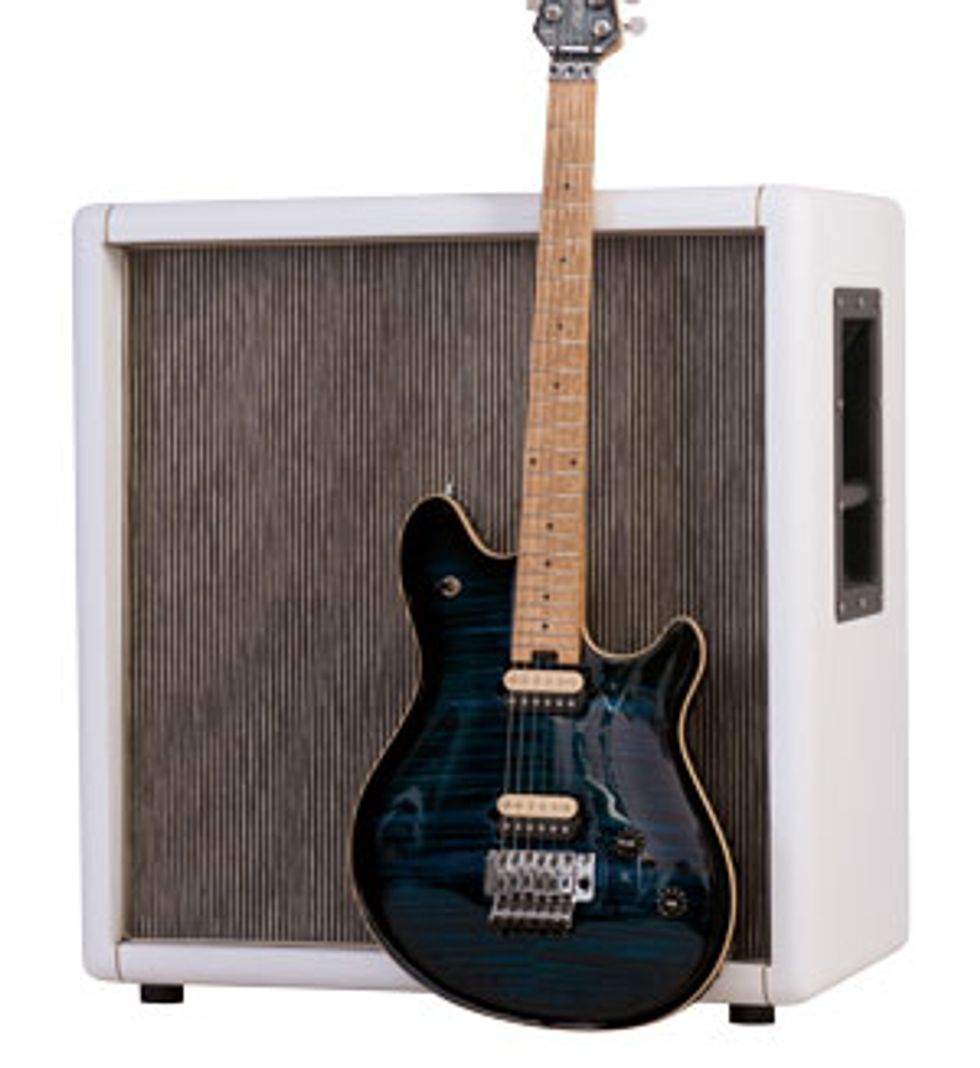
Featuring white rolled Tolex, sleek elegant rolled edges, gold piping and trim, and handwired series Marshall pinstripe grille cloth. Custom Shop EVH Peavey Wolfgang Moonburst guitar with detailed flame maple. Photo-by-Andy.com
Tell us about some of your builds.
My most recent amp is based on a 1966
Marshall JTM45/100. I went all out on
details, so it’s cosmetically and sonically like
the original. The back panel has the proper
gold font—even the misaligned “III” in
“MK III”—and the dot in the second “i”
in “Amplifier” is slightly oval, as per the
original amps. The gold knobs on the front
panel are old and nearly identical to vintage
Marshalls. The circuit board is NOS
Paxolin, as per the originals. This does have
an effect on the sound. I used all NOS
original resistors found in amps from that
era. The coupling capacitors are original
Mullards with a date code of 1966.
I sourced as many original components as possible from all over the world. I even managed to source original PVC [polyvinyl-chloride-plastic-insulated] stranded wire from a guy in England who supplied Marshall with them in the ’60s. I also sourced the original pink wire to the pots and the slightly thicker diameter pink wire for the pot jumpers and input jacks, as per original amps of this era—this wire is next to extinct and plays a role in the vintage tone.
How so?
The old wire had a different molecular
structure, a different strand arrangement,
and a different grade of PVC.
Also, the old Marshall carbon-film resistors
I used are part of the tone of this
era. I find modern carbon-film resistors
much too bright for these amps, and
carbon-composition resistors lack too
much high-end fidelity.
I have experimented and A/B’d different wire. I can tell the difference between stranded and solid-core wire. I can also tell the difference between cloth-covered and stranded PVC wire. To take it a step further, there is a difference if the stranded wire is twisted inside the PVC, or if it’s all laid out parallel to each other. I see many builders today using bonded or top-coated stranded wire, and I don’t like this wire for vintage Marshall amps. It doesn’t sound right.
What specifically doesn’t sound right
about it?
Notice I said it doesn’t sound “right,” but
I didn’t say “bad.” We are talking about
vintage Marshall tube amplifiers and recreating
that original tone. The top-coated or
bonded wire does not transfer the signal the
same as a stranded wire does. By stranded, I
mean the wire’s strands are easily separated
and not tinned into one conductor. There’s
more detail in the high-end with stranded
wire. It’s harder to work with, but I much
prefer the tone for these amps. After all, isn’t
that the whole point of the build—the tone?
I think a lot of guys use top-coated wire because they don’t believe it can have an effect on the tone, or it’s easier to work with, or they simply don’t pay attention to the details like I do—or their ears can’t hear the difference. I am really particular about the kind of wire I use in different circuits, and where I use it in the circuits.
How do you find your parts?
The best way to find the original parts is to
spend an enormous amount of time contacting
every ham radio guy from England
there is. It’s similar to how guys find parts
for old classic cars. You really have to spend
a lot of time digging. I love this part of
rebuilding some of the old amps, though!
There are guys I regularly stay in contact
with from England, and I love that they
know I am putting parts they saved for the
past 40 or 45 years to good use. I read an
interview with Jeff Beck not too long ago
and he talked about looking for car parts
in America to complete his hot rods. Same
deal there.
Are there enough parts to go around to
make a big run of vintage replicas?
I have a large amount of vintage parts for
multiple vintage amp builds, but I treat it on
a case-by-case basis. If I were building a high
quantity of my own designs, I would source
new parts that gave me the tone I wanted.
What do you do if you can’t locate an
NOS part?
If I can’t find an original part, I often make
my own replacement part. In the JTM45/100
replica, I made my own internal fuse holder. I
design and make my own circuit boards for my
amps and pedals. I make my own wah inductors,
too. For wah pots, one way I build them is
by swapping the internal phenolic wafer from
an old pot into a new wah pot casing. In guitars,
I modify the pot’s internal carbon track for
a higher resistance, so they sound more like the
pots found in old Les Pauls. If making my own
part is not an option, I’ll source an alternative
NOS part or, if needed, a new part that reacts
and sounds as close as possible to the original.
Would you later replace that part with
an NOS part if you were able to track
one down?
Yes, but mostly on strict vintage builds.
Left: NOS 1960s original Radiospares carbon fi lm and carbon composition resistors. NOS 1966 Mullard
Mustard coupling capacitors. Original Marshall 1960s PVC stranded wire—green, blue, yellow, purple,
white, black and red. Original Marshall 1960s PVC Pink stranded wire, as well as original thicker diameter
1960s Marshall pink wire for pot jumpers/input jacks, per original spec of this era amplifi er. NOS rare
arched-logo RS silver mica capacitor. NOS Radiospares silver mica tone stack capacitor. NOS custom
made perforated Paxolin board from the UK, with original Radiospares split turrets. PEC military-grade
stainless steel body, steel shafts, and gold contact potentiometers.
Right: NOS tube sockets. NOS BY137 bullet diodes. NOS BY114 Mullard top-hate diode for bias supply.
High quality Rifa brand electrolytic capacitors. 1960s original Radiospares black wire wrap. NOS
tube sockets. Cliff UK jacks. New Marshall impedance/voltage selector for reliability. Custom transformers
from Merren Audio—through years of extensive testing they were the only transformers that
accurately reproduced the original sound.
What about the cabinets? Do you make
them yourself?
Yes. I couldn’t find Marshall cabinets or ones
on the market today that had the look or tone
of the old ones, so I started building them.
My father is a carpenter and stonemason.
Together, we started dovetailing and designing
cabinets from scratch out of Baltic birch plywood,
and soon we are going to use a slab of
pine that’s a few hundred years old for builds
based on the tweed Bassman and tweed Twin.
What’s the price range for your product line?
My Vox Clyde McCoy wah replicas range
from $300–$500, and my Vox Grey wah
replicas normally range from $500–$650,
depending upon what actual NOS components
are used. The Grey wah replicas are
handwired on old Radiospares circuit boards,
with all NOS components, including inductors.
For amps, it depends on the build and
whether cabinets are involved. To put an
average price figure, I’ve been offered $4,000
to $5,000 for the recent JTM45/100-inspired
build. But that one is my personal amp. It
means something to me and isn’t for sale.
If the price of your NOS-equipped amps is
partly influenced by the use of NOS parts,
what happens to its value after the amp is
used and the parts are either no longer NOS
or are replaced by modern components? For
instance, is the $5,000 amp worth less when
the parts, which directly influence the cost,
are no longer present or new?
No, I don’t feel using the amp makes it lose
its value. But, yes, any component replaced
with a modern part can alter the original
tone of the amp. How much of a tonal difference
there is, I can’t say. It depends what
part you are talking about.
I also want to say that I don’t just copy old tones. I like to move ahead and look forward. I often use original tones as something to aim for. I feel there is a fine line between someone who chases that “brown sound” that so many do—and who also go about it the wrong way—and someone who uses the original tones of the greats as a springboard. I feel that recreating original amps and tones is only the beginning. It’s not the end goal most of the time. I think it would be very boring if everyone just copied someone’s playing style or tone.



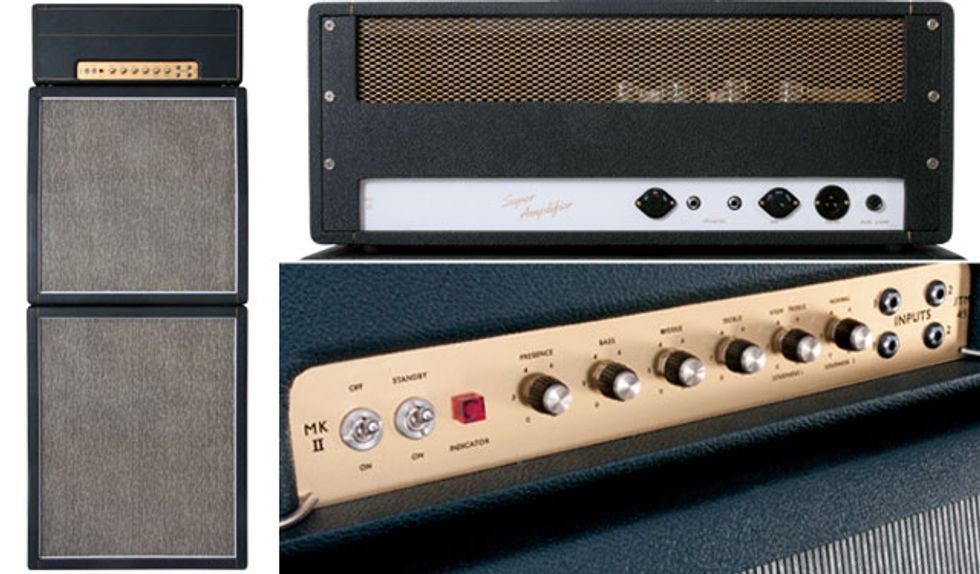
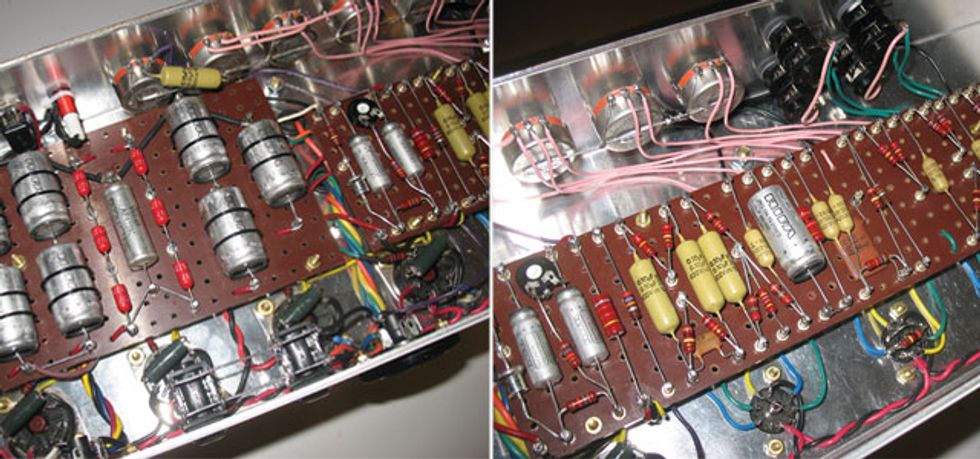




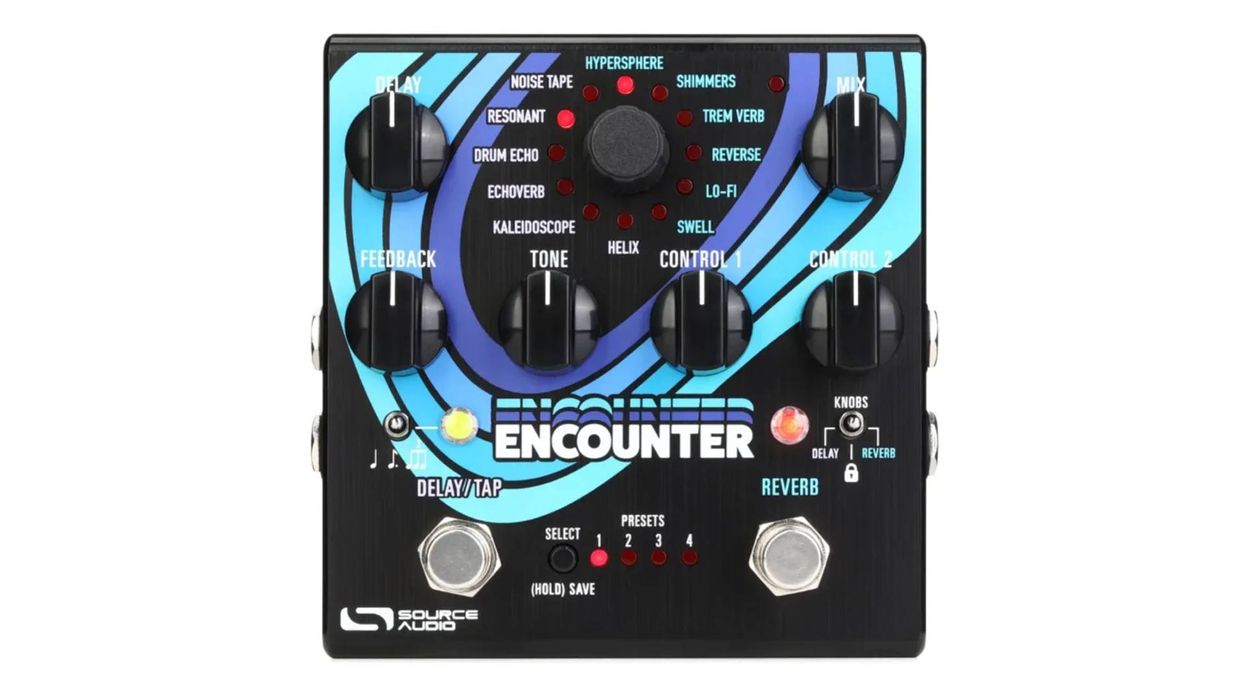


![Rig Rundown: Russian Circles’ Mike Sullivan [2025]](https://www.premierguitar.com/media-library/youtube.jpg?id=62303631&width=1245&height=700&quality=70&coordinates=0%2C0%2C0%2C0)








